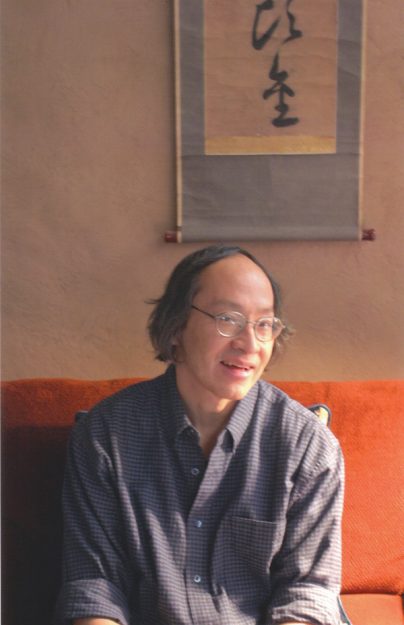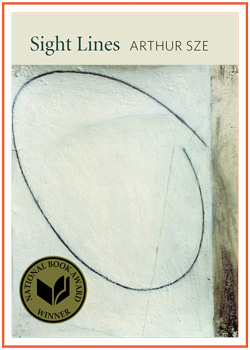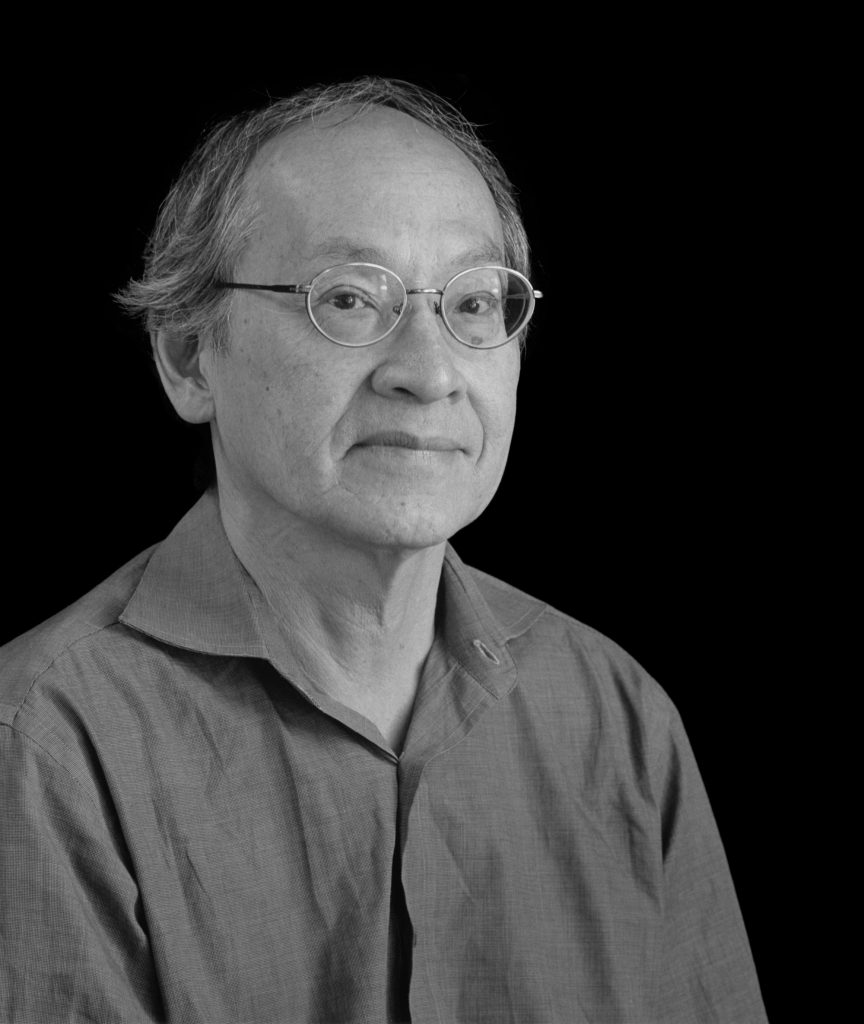Arthur Sze is a poet who pays close attention. When his tenth poetry collection, Sight Lines (Copper Canyon Press, April 2019), won the coveted National Book Award for Poetry this past November, the judges said the work “unfurls like ink in water, circulating through meditations on the natural world . . . A keen awareness arises of structural, environmental, and social threats in the midst of this expansive beauty.”
This kind of “deep noticing”—which is how Sze’s contemporary Dana Levin describes his poetry—has earned him many awards, grants, and fellowships, such as a Guggenheim Fellowship, two National Endowment for the Arts fellowships, a Lannan Literary Award, an American Book Award, and a place as finalist for the Pulitzer Prize for Poetry.
I first met Sze at Kundiman, a summer retreat for Asian American writers in The Bronx. In our workshop, he was a warm and caring presence. It was a true privilege to learn from a fellow Asian American poet who has been writing, translating, and publishing for decades. Both Sze and I arrive to Buddhism and Taoism partly as lived cultural legacies received from our families. And for both of us, poetry is an important way to live and explore insights from these traditions.
Recently, we reconnected to discuss his latest work.
Congratulations on your recent National Book Award! In your acceptance speech, you said, “We need poetry now more than ever.” What role do you think poetry plays in today’s world?
Poetry has a crucial role to play in our lives, society, and the world. It helps us slow down, hear clearly, see deeply, and envision what matters most in our lives. When one reads a poem, one has to pay attention to the sounds of words, to the rhythm of language, experience the dance and tension between sound and silence. A good poem communicates viscerally in the body before it’s fully understood in the mind, and, in that experience, complexities of feeling and thought can sometimes only be conveyed through poetry. I forget which Zen monk wrote,
what comes from brightness, I strike with brightness;
what comes from darkness, I strike with darkness
but here’s an example of emotional and imaginative insight, and how to proceed in the world, compressed into a few words, where each word matters. [The quote comes from 9th century Chinese master Linji Yixuan (Jp. Rinzai).] Prose can explain and lengthily articulate the meaning in those two lines, but only poetry, I think, can capture and embody the experience.
Our world today is built on various assumptions—“time is money,” for example—and we live in an age that although globally connected is not necessarily humanly connected. People work endless hours buying and selling stocks and bonds—“buy silk, sell steel”—for instance. Poetry stands in resistance to this commercial culture. It is not about acquiring material wealth; instead, it’s about human insight, genuine human connectivity, and promotes mindfulness and awakening. In that way, poetry is priceless. And, in that way, I have devoted my life to poetry for over 50 years. Poetry, for me, is about discovery, renewal, awakening, and affirming a way of living that is profound, humbling, and meaningful.
The first thing that struck me about Sight Lines is its multi-faceted juxtapositions of many moments and places. Elsewhere you have mentioned that the Buddhist-Hindu metaphor of Indra’s net—in which an infinite number of jewels hang, reflecting every other jewel—was an unstated structure for the final poem in the collection, “The Glass Constellation.” Could you say more about how the book engages with the idea of interdependence?
Like it or not, we live on a planet that is interconnected and interdependent. A contemporary physicist can invoke the “butterfly effect,” and assert that a butterfly flapping its wings off the coast of Yucatán can cause a tsunami off the coast of Japan. The world is interconnected in ways we can see and also in ways that are unseen. Unlike a traditional narrative poem where a story unfolds in one place in linear fashion, I believe poetry today needs to find ways to make a reader experience the simultaneity, multiplicity, and sometimes bewildering complexity of our worlds.
In “The Glass Constellation,” the backdrop of Indra’s net helped give me the structure to write an extended poem, where so many events are happening that a reader or listener cannot keep them all in mind. And, in fact, that is part of its meaning. There is no hierarchy promoted in the vision of the poem—a woman begs at a bakery, an explosion in an underground uranium mine shatters windows in the village above, a magpie hops onto an apple tree stump—and the reader is, I hope, immersed in and invited to consider the unfolding mystery of our world.
The use of one-liners that move through the book is another way of engaging the reader with interdependence. They are like one-line haikus or koans. A reader encounters these in between titled poems. They come and go without explanation. These destabilize the text and invite the reader to look for and search for connection. Why are these lines here? Why do they come and go unpredictably? I’m presenting flashes or glimpses of experience that will return in the title poem, “Sight Lines,” [which is] the next-to-last poem of the book. In “Sight Lines,” I see these one-liners, appearing earlier like geometric skew lines moving through space and time, finding their place and enabling a reader to hopefully see and experience things again for the first time. This is important because it enables a reader to develop insight that can then be activated or utilized in [decisions about] how to live, where to go.

Sight Lines seems to draw aesthetically and linguistically from both North American and Chinese poetry lineages. How would you describe your creative influences, how do they inform your approach to writing, and has this changed over time?
My creative influences are global, and they are not restricted to North American and Chinese poetry lineages. For instance, conversations with particle physicists Murray Gell-Mann, George Zweig, and Richard Slanksy in the mid-1980s were very important to me. Conversations with the Mayan translator Dennis Tedlock were important to me in the 1990s. These conversations had to do with emptiness and fullness, vision, and language, and they have informed the evolution of my sequences.
In North American poetry, my early poetic influences came through my two teachers, Denise Levertov and Josephine Miles. (I only took two writing workshops in my life, and never went to graduate school.) Denise approached language through her training as a dancer, and her obsessions with sound, fractional pauses, and silences were important to me. Through her I became very interested in Black Mountain poetry [from North Carolina in the 1940s and 1950s] and the collaborations that were happening between those poets and artists. At UC Berkeley, Josephine Miles was my adviser, and I created my own major in poetry under her guidance. I learned so much of my craft—attention to sound, rhythm, form—from Josephine, though it took me so many years to fulfill that early potential. I have to say that I came to [Walt] Whitman rather late; he was so poorly taught in high school that I avoided his work for years, but his enduring sequences challenged me and made me think carefully about how to organize tonal shifts in large sequences.
From the Chinese poetic tradition, I’ve drawn, first, on texts that I’ve translated from the Tang dynasty (618–907) poets Li Bo, Wang Wei, and Du Fu, to their more hermetic contemporaries Li He and Li Shangyin. I’ve learned from and absorbed the poems I’ve translated by writing out the poems in my own poor handwriting, character by character, stroke by stroke. In translating them into English—an impossible task—I’ve considered how the poems were created, the imaginative and emotional force behind the language, and I’ve also come to recognize how juxtaposition is, for instance, not just an artistic procedure or tool but a vision of the world. Because classical Chinese poems are dense, I’ve also had to consider how the ancient poems are layered in meanings, and that has been a strong influence on my own poetry in English. Translating modern Chinese poets, particularly Wen Yiduo (1899–1946), was especially important to me, because Wen knew the classical tradition but broke it apart to serve his own aesthetic needs. I came to a place in my thirties where I, too, had absorbed the classical poetry and needed to break it apart. Wen’s innovative yet highly architectural forms and colloquial diction helped point the way.
It seems like your use of Chinese characters and struck-through words is also a way to destabilize the text. I appreciate this as a multilingual person, and for other readers it probably causes them to stop and think about what is happening, perhaps it creates an opening.
Yes, I’d like to start with the struck-through text. I first developed this procedure in collaborating with sculptor Susan York here in Santa Fe. In her drawings, Susan likes to use 60 to 70 layers of graphite to create luminous depth. I wanted to explore how the process of creation could become the product, and I decided to develop a few monologues where a speaker says something but then revises and strikes through it.
To make that tension visible, strike-through lines became an important way to show that revision in a person’s voice and/or mind. The strike-throughs have to do with accuracy.
Then I learned that [the 20th century German philosopher] Martin Heidegger advocated for strike-through lines and said: “Because the words are necessary, they remain legible. Because the words are inaccurate, they are struck through.” I like what he affirmed, but I came there by a very different route.
In terms of my use of Chinese, I sometimes refer directly to Chinese characters, as in the opening section to “Water Calligraphy,” where I write:
at the bottom of a teacup,
leaves form the character individual
and, after a sip, the number eight.
This passage has to do with how tea leaves can move and create different words and meanings, and also with divination with tea, and a recognition that language is something fragile and miraculous. In destabilizing the text, I hope a reader starts to read and experience viscerally, with their nerves, and not take anything for granted. Of course, my use of Chinese goes beyond the use of characters; it includes not only how they are composed and exist in a form of simultaneity and magnetic tension but also presents a vision of the world.

Sight Lines is filled with moments from the human and natural worlds, encounters between them, and occasional punctuations of violence and eros. What do you see as the relationships, the sight lines, between these elements?
I am trying to play, imaginatively and emotionally, with the wide spectrum of human experience in the 21st century, and also to deepen our perceptions and experiences. Rather than intellectually trying to articulate the different relationships, I prefer to invite the reader to find their own valuable insights and connections. I will say that the short title poem is foundational and serves as a microcosm that is enlarged in the macrocosm of the book.
In “Courtyard Fire,” you quote/paraphrase Karl Marx, “the call to abandon illusions / is a call to abandon / a condition that requires illusions”. What do you feel are the “illusions” that Sight Lines is trying to abandon?
One of the “illusions” Sight Lines is trying to abandon has to do with self, ownership, and possession. In “First Snow,” I come out directly and state it:
you think you own a car, a house,
this blue-zigzagged shirt, but you just borrow these things.
The theme is picked up on a larger but subtler scale in “Sight Lines,” where “the ditch ran before the year of the Louisiana Purchase.” With that line, the history of the United States, Thomas Jefferson, Manifest Destiny, settler colonialism, and expansionism are all brought into focus. Suddenly, land is not something to be shared but to be bought and owned.
The poems, in their way, struggle with larger issues of attachment and letting go.
“Sight Lines” brings into focus many of the forces that are in collision today. If I make these forces visible, the reader has to decide how to respond. I hope they will act with mindfulness and care, in small ways that help build a sense of community.
Thank you for subscribing to Tricycle! As a nonprofit, we depend on readers like you to keep Buddhist teachings and practices widely available.
